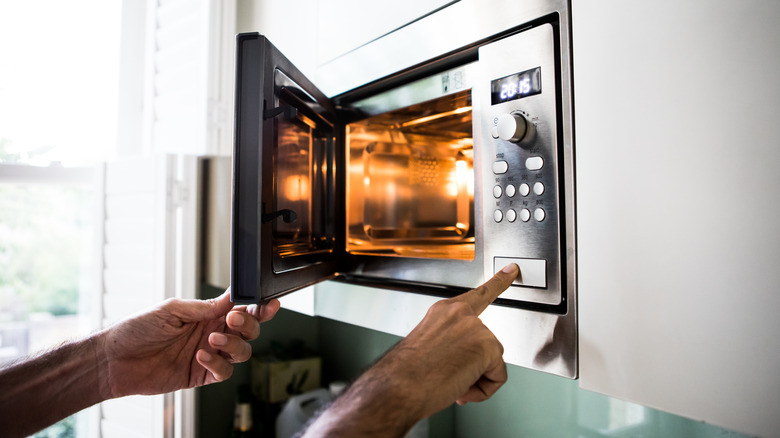Recirculating Venting Vs. External Venting In A Microwave Oven
A microwave oven designed to be mounted over a cooktop is usually equipped with a ventilation system to cope with the cooking odors, smoke and moisture that rise from the cooking surface. The ventilation system may lead to an exterior vent, or it may simply recirculate air back into the kitchen.
A recirculating vent has advantages in terms of ease of installation and energy efficiency, but it pays for those advantages at the cost of effective ventilation. Learn about the advantages and disadvantages of recirculating venting vs. external venting in a microwave before purchasing a new model.
Exhaust Effectiveness: Recirculating vs. External
An externally vented microwave uses a fan to draw air through the microwave's vents and into an exhaust duct leading to the exterior of the building, which means that most of the moisture, heat, odor and particulate matter generated by cooking goes directly outside. A ductless recirculating vent pulls air through a filter and exhausts the air back into the kitchen.
Some units are equipped with a charcoal filter that traps some particulate matter and odors, but most of the heat and moisture, along with some types of particles, stay in the house. Other units use aluminum filters that trap grease but not much else. On the other hand, recirculating vents don't exhaust conditioned air to the outside, so they can help make a kitchen more energy-efficient.
Vent Installation Costs
Installing a microwave with a recirculating vent is generally much easier and cheaper than installing an externally vented unit, which requires the installation of ductwork and an exterior vent cap, as well as the piercing of a wall, ceiling or roof. An external vent requires access to the outside, so it's most conveniently located on an exterior wall, but — as Apollo Heating & Air Conditioning notes — a recirculating unit can be easily installed on an interior wall, and it can be moved relatively easily too.
If you want to install an over-the-range microwave and have it up and running within the hour, it's best to choose recirculating venting vs. external venting. Likewise, if you want to keep costs down, you may want to choose a microwave with recirculating venting to avoid having to pay someone to cut through the exterior wall.
Different Vent Requirements
When you install an externally vented unit, the vent needs to conform to common building standards in order to be safe and effective. Your microwave will come with vent installation instructions from the manufacturer, but these may not include specifications adhering to all of your local building codes.
The vent duct should be made from galvanized steel, stainless steel or copper, and it should have a smooth interior. The vent should always exhaust to the outside, not into an attic or any other interior space. In some places, local building codes may specify a minimum distance between an exterior vent and any adjacent door, window or other structure. Because recirculating vents have no exterior components, they're not subject to these requirements.
Exhaust Filter Maintenance
The charcoal filter in a recirculating vent will lose its effectiveness over time and use. You will need to replace it periodically using manufacturers suggestions. In general, a filter will last for six to 12 months, but frequent cooking may reduce its life span.
Aluminum filters require regular cleaning with a degreasing detergent. According to KitchenAid, you can also wash most grease filters in a dishwasher, but check your owner's manual to confirm before tossing yours in the dishwasher.
